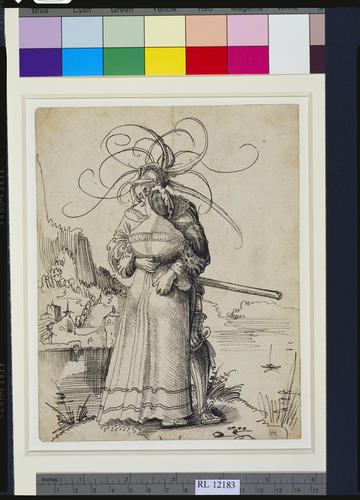A couple embracing on the shore of a lake c.1516
Pen and black ink | 18.4 x 14.5 cm (sheet of paper) | RCIN 912183
-
A pen and ink drawing of a couple embracing.
This drawing is typical of the work of the Swiss artist and mercenary Urs Graf, an idiosyncratic and prolific draughtsman. Graf was the son of a goldsmith; by 1511 he had established himself in Basel as a designer of stained glass and prints. Graf's career in Basel was disturbed by regular episodes of violence and in 1518 he was forced to leave the city after attempting murder. The city council recalled the artist from exile to work for the Basel mint in 1519, having decided that his talent as a die cutter outweighed his violent character. Graf undertook regular campaigns as a Swiss mercenary and was a member of the vanquished army at the battle of Marignano in 1515, a catastrophic defeat which traumatised participants.
This work shows a soldier embracing a woman, probably a prostitute, by a lake. Graf's deft penmanship is shown in the economical depiction of the landscape - in which loops denote trees and a handful of strokes become a boat - and in the exuberance of the feathers in the man's cap. Exotic dress was a hallmark of the mercenary, whose itinerant lifestyle meant that money was quickly converted into items that were easily portable. Although the scene is one of calm, in which both the figures and the landscape appear still, an underlying aggression, both physical and sexual, is provided by the perpendicular sword, a phallic as well as a military symbol.
The drawing has been trimmed at the bottom, which retains the top of the two upstrokes of Graf's VG monogram. A date, often added by Graf to his drawings, may have been lost at the same time. The work probably dates from around 1516, in which year Graf produced a number of drawings exploring the theme of lovers on a shoreline. Like many of Graf's drawings, this was surely intended as a finished work in its own right.
Two-thirds of Graf's surviving drawings remain together in Basel, as part of the sixteenth century collection of the lawyer Basilius Amerbach, who probably acquired them directly from the artist's estate. Many of these drawings are finished works and it seems that Graf often drew for personal satisfaction or to make gifts for close friends rather than for commercial ends. The present drawing's independence of the Amerbach collection may indicate that it was presented or sold by the artist during his lifetime. The subjects of his drawings often appear to be partially autobiographical and include lavishly attired soldiers and prostitutes (with whom he was more than once criticised for associating), as well as artists' stock images of religious scenes and military figures. Although Graf's work stands out from that of his contemporaries as idiosyncratic, it is also clear that he was aware of the work of his two great contemporaries Martin Schongauer and Albrecht Dürer, whose prints ensured wide knowledge of their techniques and motifs. The present drawing may have been inspired by an engraving by the Master MZ, which depicts a couple embracing in an interior.
Catalogue entry adapted from The Northern Renaissance. Dürer to Holbein, London 2011Provenance
First recorded in a Royal Collection inventory of c.1800-1820 (Inv.A, p.14: 'Albert Durer e Maestri Antichi Divsi.')
-
Creator(s)
Acquirer(s)
-
Medium and techniques
Pen and black ink
Measurements
18.4 x 14.5 cm (sheet of paper)
Object type(s)
Other number(s)
RL 12183











